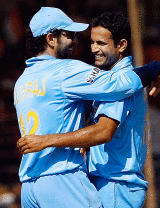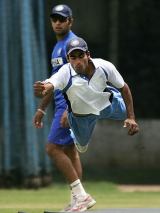Fielding and the ground realities
Jamie Alter
06-Feb-2007
|
|

|
Cricket, like chess, is won in the field and India's squad for the Sri Lanka series- which will form, almost in toto, the World Cup squad - has a prominent Achilles heel that could turn check into checkmate: The quality of its fielding. Conventional wisdom, which Greg Chappell also subscribes to, is that the World Cup will be won by the best fielding side but a cursory glance at the men Chappell has to work with suggests an excess of cellulite.
Yuvraj Singh is the best fielder, with Suresh Raina, Dinesh Karthik and Robin Uthappa to follow. Raina and Gautam Gambhir, unconvincing with bat but assets in the field, failed to make the cut for the Sri Lanka series, but could still be in the reckoning for the Caribbean trip. Ajit Agarkar has a great arm and is very good in the deep, Sachin Tendulkar is a safe pair of hands but his throwing at the stumps has slipped from great heights. Sreesanth is quick on his feet but hasn't done anything to suggest he's a livewire in the field, and Irfan Pathan is no AB de Villiers. That leaves Virender Sehwag, Rahul Dravid, Sourav Ganguly, Anil Kumble, Zaheer Khan, Harbhajan Singh. Hardly the Oxford University Cross-Country Club.
And then there's Munaf Patel. His lacklustre display in the Test series in South Africa - abysmal throwing, balls regularly rolling through his legs, batsmen adding a run when the ball went near him - went from the comical to the infuriating and may work against his inclusion in the final XI.
Yet Munaf is only the most visible manifestation of the problem. India have fielded superbly in patches, but it's not hard to remember an abysmal fielding performance. In the TVS Cup final at Kolkata in late 2003, India grassed five chances. By dropping Ricky Ponting and Matthew Hayden twice each and Michael Bevan once, India allowed 82 extra runs, and lost the match by 37. That also equates to Australia playing with five extra batsmen.
On day three of the second Test against Zimbabwe at Harare in September 2005, three easy catches went down in three deliveries. And in the 4-1 loss in the West Indies last year, India were let down by some horror displays, not least in the dead rubber at at Trinidad, where Mahendra Singh Dhoni, Uthappa and Munaf all had bad days.
And just in case you thought that good fielding was the preserve of teams from the Southern Hemisphere, enter Sri Lanka, who have turned matches around based purely on their throwing, diving and catching. Under a new captain and coach, Sri Lanka have put an emphasis on fielding, and have looked genuinely top-class. Perhaps the most electrifying in recent times was Tillakaratne Dilshan's brilliance in the first final of the 2005-06 VB Series when he effected four run-outs and took a catch to derail Australia's chase of 275.
|
|

|
Key to Sri Lanka's 5-0 whitewash of England last summer was their electric stops and stunning catching inside the circle. In New Zealand recently, there were outstanding fielding performances in a 2-2 result, with New Zealand matching Sri Lanka dive for dive and catch for catch.
Australia and New Zealand have shown the value of putting a premium on ground fielding. Australia, Dad's Army tag and all, are an outstanding unit; New Zealand don't have a great bowling attack, but they make up for that with their ground fielding; and even West Indies, in Chennai recently, caused a dramatic turnaround - derailing India from 232 for 3 in the 35th over to 268 in 48 overs - with some athletic fielding.
India need to place a similar premium on their fielding at the World Cup. The team management can't correct the fielding in four games but it can try and ensure a strong core for the World Cup by paying attention to a key aspect of the game and by fielding the young blood. If that equates to Karthik playing ahead of Pathan, still so scarily unconvincing, so be it.
Why Mohammad Kaif isn't in the picture is up for debate, but what he would bring to this side is enthusiasm and brilliance in the field. India's two best one-day feats in recent years - Lord's, 2002, and reaching the 2003 World Cup final - were forged on the energy, enthusiasm, versatility and attitude of Yuvraj and Kaif, the beacons of a new mindset. They need to be reunited in the field so that they can inspire their leg-weary seniors.
Picture Yuvraj lurking between backward point and gully, Kaif prowling at cover, Raina at midwicket and Karthik adept either side of the pitch, and you're inspired to root for this team.
Jamie Alter is editorial assistant of Cricinfo